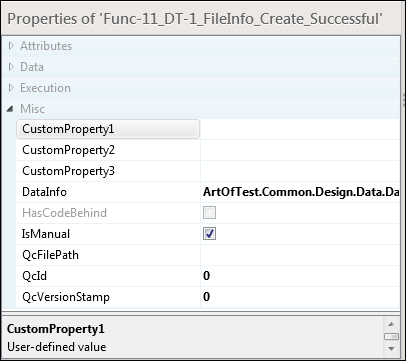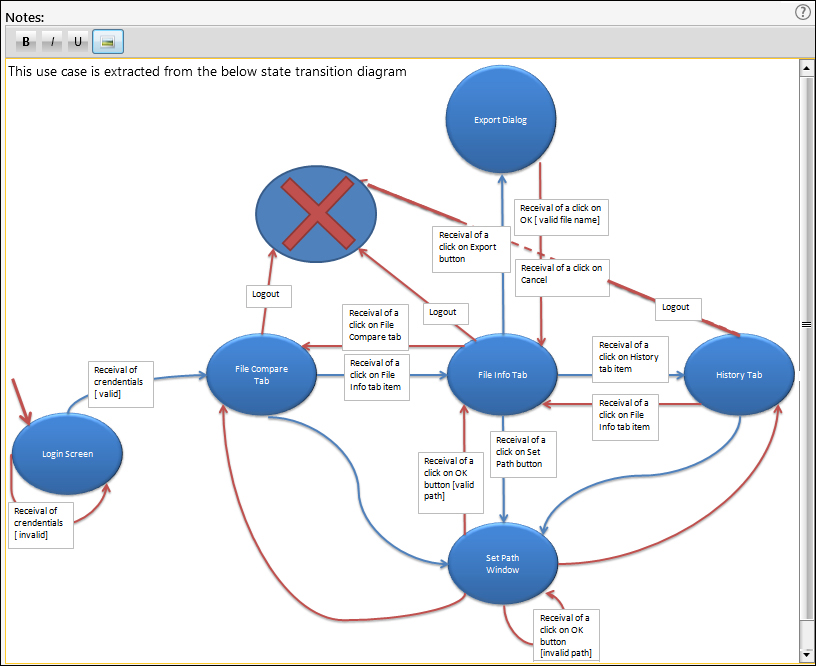So far we have learned how to integrate Test Studio within test management and execute activities of the manual testing process. This section inspires you on how you can style tests by using what Test Studio intrinsically offers to easily locate, filter, and group tests together based on their common features.
What do we get to deal with during manual tests' generation and implementation? Test design documents, test cases documents, test data stores, and what not. Earlier, Test Studio had presented a built-in solution to inherently combine a test with its test data, thus solving the problem of storing and maintaining them alongside. This time it will provide another solution to link test cases to their test design documents and from that achieve a more complete solution towards a consolidated test repository.
The following will briefly illustrate some of the functional testing techniques applied against the File Comparer application features to generate sample test cases, which will be later inserted into Test Studio.
Decision table is a functional design technique used for testing the application's behavior resulting from a combination of business rules. This technique is used to filter down to the smallest set that safely covers all the testing for a feature without having to exhaustively test all combinations.
While automating data-driven tests for the File Info application, we have encountered certain rules that manage the submission of the file's metadata. The decision table for the File Info application can be found in the Decision Table sheet of the File Comparer – Manual Test Scripts.xlsx workbook. The upper section of the table contains the conditions that are listed vertically. The lower section contains the actions that correspond to the system feedback and are also listed vertically. The system feedback is dependent on the conditions and varies based on their combinations. A test case is extracted by vertically reading a column from the table.
Using the Excel import feature, construct a manual test having Test Case 1 - Description for its procedures by performing the following steps:
- Create a manual test under the
Manual Test Scriptsfolder and rename it toFunc-11_DT-1_FileInfo_Create_Successful. - In the Import ribbon of the test, click on the Excel Import button.
- Browse for the Excel workbook and specify the sheet and table for the Import Manual Step window.
Upon clicking on OK, the manual steps are added to the tests. Firstly, we will build the link to the test design; afterwards, we will adjust the manual test attributes to provide more information suitable for classifying the test based on its type.
Therefore, take a snapshot of the decision table and save it on your local machine drive. Then using the Attach image button of the Notes section in the manual test work area, browse for the decision table snapshot, and enter a descriptive text as depicted in the following screenshot:

Adding a decision table design to a manual test
Go back to the Project tab, and select the test in order to edit its properties. The Misc section of the test has three custom properties as shown in the following screenshot:

Custom properties for manual tests
These properties are made available to conventionally classify and categorize tests based on their values. Depending on the testing automation environment in your company, you might decide to map these properties to a certain test criteria. In this example, CustomProperty1 will stand for the test design technique that was used to generate the test. CustomProperty2 will be used to denote the feature under the test, whereas CustomProperty3 will refer to the test state of completion. A True value stands for a completed test ready for execution, whereas False means that the test is still under development.
Accordingly, enter the values for these properties as Decision Table, File Info Submission, and True respectively.
State transition diagrams are directed graphs used to draw system transitions between different finite states. They have the ability to predict the next state based on the previous state of the system in addition to a certain condition.
State transition diagrams also reveal the system events that translate feedback to the user in case they are present. The state tests sheet of File Comparer, which is the Manual Test Scripts.xlsx workbook, has the state transition diagram for the various system functionalities.
Using the Excel import feature, construct a manual test having Use Case 1 – Description for its procedures by performing the following steps:
- Create a manual test under the
Manual Test Scriptsfolder and name it asFunc-12_SD-1_FileInfo_Create_Successful. - In the Import ribbon of the test, click on the Excel Import button.
- Browse for the Excel workbook and specify the sheet and table for the Import Manual Step window and then click on OK.
- Save a snapshot of the state transition diagram on your local machine. Next, import it into the notes of the manual test by providing a descriptive text as depicted in the following screenshot:

Adding a state transition diagram design to a manual test
Go to the Project tab, select this test, and update its custom property values as follows:
CustomProperty1:State Transition DiagramCustomProperty2:File Comparer full set of operationsCustomProperty3:True
